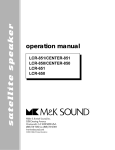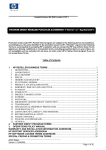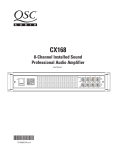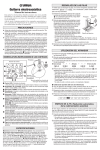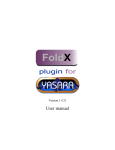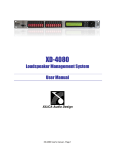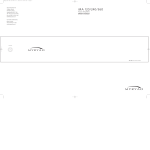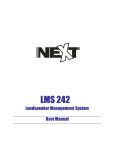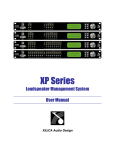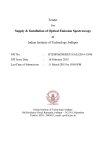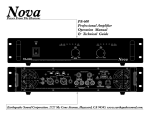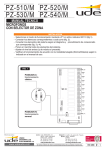Download TSL Timetable Sound Level Controller
Transcript
TSL Timetable Sound Level Controller Firmware v1.3 Pol.Ind.Norte-Perpinyà,25 08226 TERRASSA (Barcelona-SPAIN) [email protected] www.master-audio.com User Manual April 2009 Amate Electroacústica,s.l. ESPAÑOL CAUTION RISK OF ELECTRIC SHOCK DON’T OPEN WARNING: To reduce the risk of fire or electric shock do not expose this equipment to rain or moisture Safety Instructions 1. READ THESE INSTRUCTIONS All the safety and operating instructions should be read before the product is operated. 2. KEEP THESE INSTRUCTIONS The safety and operating instructions should be retained for future reference. 3. HEED ALL WARNINGS All warnings on the product and in the operating instructions should be adhered to. 4. FOLLOW ALL INSTRUCTIONS All operating and use of instructions should be followed. 5. DO NOT USE THIS APPARATUS NEAR WATER Do not use the product near water. For example, near a bathtub, washbowl, kitchen sink, or laundry tub, in a wet basement, or near a swimming pool, and the like. 6. CLEAN ONLY WITH DRY CLOTH Unplug the unit from the wall outlet before cleaning. Do not use liquid cleaners or aerosol cleaners. Use a damp cloth for cleaning. 7. DO NOT BLOCK ANY VENTILATION OPENINGS Slots and openings in the cabinet back or bottom are provided for ventilation, to ensure reliable operation of the limit and to protect it from overheating. These openings must not be blocked or covered. The openings should never be blocked by placing the product on a bed, sofa, rug, or similar surface. This product should never be placed near or over a radiator or heat source. This product should not be placed in a built-in installation such as a bookcase or rack unless proper ventilation is provided or the manufacture's instructions have been adhered to. 8. DO NOT INSTALL NEAR ANY HEAT SOURCES This Product should be situated away from heat sources such as radiators, stoves, or other products (including amplifiers) that produces heat. 9. DO NOT DEFEAT THE SAFETY PURPOSE OF THE POLARIZED OR GROUNDING-TYPE PLUG A Polarized plug has two blades with one wider than the other. A grounding-type plug has two blades and a third grounding prong. The wide blade or the third prongs are provided for your safety. If the provided plug does not fit into your outlet, consult an electrician for replacement of the obsolete outlet. TSL Ver 1.0 ENG Apr 09 2 Amate Electroacústica,s.l. 10. PROTECT THE POWER CORD FROM BEING WALKED ON OR PINCHED PARTICULARLY AT PLUGS, CONVENIENCE RECEPTACLES, AND THE POINT WHERE THEY EXIT FROM THE APPARATUS. 11. ONLY USE ATTACHMENTS/ MANUFACTURER. ACCESSORIES SPECIFIED BY THE 12. UNPLUG THIS APPARATUS DURING LIGHTNING STORMS OR WHEN UNUSED FOR LONG PERIODS OF TIME. For added protection for this unit during a lightning storm, or when it is left unattended and unused for long periods of time, unplug it from the wall outlet and disconnect the antenna or cable system. This will prevent damage to the unit due to lightning and power line surges. 13. REFER ALL SERVICING TO QUALIFIED SERVICE PERSONNEL. SERVICING IS REQUIRED WHEN THE APPARATUS HAS BEEN DAMAGED IN ANYWAY, SUCH AS WHEN THE POWER SUPPLY CORD OR PLUG IS DAMAGED, LIQUID HAS BEEN SPILLED OR OBJECTS HAVE FALLEN INTO THE APPARATUS, THE APPARATUS HAS BEEN EXPOSED TO RAIN OR MOISTURE, DOES NOT OPERATE NORMALLY, OR HAS BEEN FROPPED. 14. WARNING: TO REDUCE THE RISK OF FIRE OR ELECTRIC SHOCK, DO NOT EXPOSE THIS APPARATUS TO RAIN OR MOISTURE. 15. APPARATUS SHALL NOT BE EXPOSED TO DRIPPING OR SPLASHING AND NO OBJECTS FILLED WITH LIQUIDS, SUCH AS VASES, SHALL BE PLACED ON THE APPARATUS. TSL Ver 1.0 ENG Apr 09 3 Amate Electroacústica,s.l. 1.INTRODUCTION In view of the fact that the requirements of audio professionals are increasingly greater, we would like to thank you for choosing a MASTER AUDIO product. At AMATE ELECTROACÚSTICA, we have incorporated the highest technology into our products with the conviction that what you have purchased will give you optimum performance and operation however adverse the working conditions to which you may submit it. In order to achieve the best performance and correct operation, it is important that you read the instructions manual carefully before making any connections. The TSL is designed for an automatic control of the sound level in all sorts of closed premises with musical environment: "Live" or "Discotheque". It is compliant with the basic City Laws controlling the Regulations on Acoustic Exposure in Public Premises in General. It includes four possible time intervals per day with independent Attenuation and builtin power supply through rechargeable battery. It also includes a Microphone Controller of Environmental Noise (SLO), which acts directly upon the Input Signal adjusting it proportionally to the actual acoustic reading at all times. Package contents: - TSL unit AC power cord TSLMIC special microphone for environmental sound measurement. External LED indicator: Limiter Active/Signal Excess, for remote monitoring. Sealable back cover WARNING: The TSL does not allow Boycotts. That is why it does not have an “Incident Register” because there CANNOT be any. Any breach of the Operation Regulations is Responsibility of the Owner of the Premises -where the breach has taken place- before the corresponding Authorities. IMPORTANT: The microphone supplied with the TSL is not a regular microphone. Under any circumstance use this microphone for applications other than the ones described in this manual. IN the same way, never connect a conventional microphone to the TSL microphone output. Both equipments may be damaged. TSL Ver 1.0 ENG Apr 09 4 Amate Electroacústica,s.l. 2.FEATURES - 4 attenuation modes, two of them with adjustable limiter threshold (DAY, NIGHT), one for complete silence (MUTE) and another one to eliminate the limiter effect (BYPASS). - 2 balanced inputs and 2 balanced outputs with XLR-3 connectors. - High signal-to-noise ratio - Limitation controlled by high quality dedicated integrated circuits that avoid undesirable artifacts in the musical program. - 5-led level indicator on the front panel for: limiter input level, limiter output level, microphone level and master output level. - Input gain adjust. - Output gain adjust. - Internal buzzer: generates an acoustic signal in case of misuse (penalty). - Clock/calendar: allows establishing an independent program for each day of the week. - Memory for up to 10 special programs (bypass dates) for special days or events. - Microphone for environmental sound level metering (optional use) - EXTERNAL LED INDICATOR: with pre-warning of Penalization for the D.J - Integrated PINK NOISE generator: Included to ease maximum Accuracy in Adjustments - 2x16 character blue backlit LCD, displays limiter mode and current date and time. - Controls and connections sealable independently: front panel adjustments, programmer control and back panel (connections). TSL Ver 1.0 ENG Apr 09 5 Amate Electroacústica,s.l. 3.THE FRONT PANEL A D B C E F G A) Front panel adjustment seal – Sliding the sealing screw to the left, the limiter adjust levels and the microphone section controls are protected. B) Microphone Selection (SLO) – This section enables the limiter control through the environmental microphone sensor (TSLMIC). This system guarantees the accurate self-control of the Environmental Level, even with Live music, with gradual attenuation WITHOUT sudden CUTS. The following controls are available: FAULT Led: Lit when a penalty situation has occurred. Please refer to “Penalty” section further in this manual for more information. Mic Out Led: Lit when the microphone option is selected, but the device does not detect a microphone connected at the output. After several seconds, the FAULT led will be activated too. Active Led: Lit if the limiter control through the microphone is active. ON Switch: Activates the limiter control through the external microphone. IMPORTANT: when this option is activated, please be sure that the microphone is connected to the TSL, otherwise a FAULT condition will occur. Threshold Led: Lit when the level read by the microphone reaches the adjusted threshold. Adjust Potentiometer: allows the adjustment of the limiter threshold through the microphone. Please refer to section “Microphone Adjust” for further details. Level Led bar: Sound level read by the microphone. C) Limiter Section – controls the Maximum Level of the authorized Acoustic Pressure. NO risk of involuntary Penalizations. It is not possible to go over the permitted level, so the signal is never meted. It is composed of the following controls: Input Led bar: Monitors the signal level at the input of the limiter. INPUT OVERLOAD Led: When lit, an excessive level of input signal is being fed to the device. If it remains continuously lit for several seconds, a penalty will occur (FAULT). Limiter Active Led: Lit when the limiter is working in order to avoid the sound level to exceed the limiter threshold. TSL Ver 1.0 ENG Apr 09 6 Amate Electroacústica,s.l. Day Adjust Potentiometer: Limiter Threshold adjustment for the time range defined as “Day”. Night Adjust Potentiometer: Limiter Threshold adjustment for the time range defined as “Night”. Output: Input Led bar: Monitors the signal level at the output of the limiter. D) Mode indicators – Show which limiter mode is currently active. The available modes are:: BYPASS: limiter disabled. Mute: output off. Night: the limiter threshold for the time range defined as “Night” is active. Day: the limiter threshold for the time range defined as “Day” is active. Pink Noise: the internal Pink Noise generator is active. The generator is only used for adjustment purposes and will not be active during normal function. E) Output level – Two five-led bars monitor at every time the audio output level, independently for left and right channels. F) Programmer Control – The LCD provides information on the current limiter mode: “DAY”, “NIGHT”, “MUTE” (output off) or “BYPASS” (limiter disabled), as well as the current date and time. The keypad allows the access to the main menu to configure the equipment. The three keys are as following: SET : enter / set value : next / increment value : previous / decrement value G) Programmer Lock – Turning the screw clockwise, the keypad is disables, thus protecting the program stores inside. It is possible to seal this screw. TSL Ver 1.0 ENG Apr 09 7 Amate Electroacústica,s.l. 4.THE REAR PANEL B A D C E F G H A) AC Input – Standard IEC socket. A compatible power cord is supplied together with the unit. The AC input range is 220 to 240VAC, 50-60Hz. B) Balanced Outputs – XLR-3 connectors for the audio output signal. The output stage is equipped with a balanced impedance topology. Connecting scheme is pin 1 for shield, pin 2 for live (+) and pin 3 for cold (-). C) Output level adjust – Allows adjusting the master output level. Please refer to section “Adjusting the limiter” for more information about this setting. D) Balanced Inputs – XLR-3 connectors for the audio input signal. The input stage is equipped with a balanced impedance topology. Connecting scheme is pin 1 for shield, pin 2 for live (+) and pin 3 for cold (-). E) Input level adjust – Allows adjusting the input sensitivity of the equipment, depending on the sound sources available. F) Input subsonic filter cutoff selection – The TSL has a built-in subsonic filter which reduces the very low frequencies. This allows optimizing the performance of the limiter and of the system in some determined situations. The filter cutoff frequency can be selected between 20, 35 or 50Hz. G) Connector for external indicator – Through a balanced cable with two Jack 6,35mm Stereo connectors, the external LED indicator can be connected here for remote monitoring. H) Connector for microphone (SLO) – Connector for the TSLMIC, when the sound level optimization option is used. A male-female XLR-3 balanced audio cable is needed here. TSL Ver 1.0 ENG Apr 09 8 Amate Electroacústica,s.l. 5.FIRST STEPS 5.1.Power up At power up, the following message is displayed on the LCD: TSL Limiter v1.3 by Master Audio The initializing process takes about 5 seconds, in which the unit is initialized and the firmware version of the TSL is shown. In the main screen, the following information is found: Current attenuation mode Date Time TSL Mode:MUTE Fri 27/09 12:23 The blinking colon ( : ) between the hours and the minutes is the marker for the seconds. The first time that the device is powered up, the internal program is empty, so the audio output is disabled (MUTE mode). Before programming the device, it should be properly initialized, as described in the following section. 5.2.Initial Setup In order to enable the keypad to access the function menu of the TSL, it is needed to unscrew the keypad lock screw (Letter G on the front panel). Once this is done, keys SET , and are enabled and it is possible to configure the device. SET From the TSL main screen and pressing and simultaneously during 3 seconds, the TSL Function Menu will appear. Using this menu the functions of the TSL can be programmed. The following message will be displayed: Select Function Change Language TSL Ver 1.0 ENG Apr 09 9 Amate Electroacústica,s.l. On the first row of the screen, the title of the current menu can always be read, being in this example “Select Function”. On the second row, the options contained in the menu can be displayed using and . With SET the displayed option is selected. Should a numeric value be changed, the corresponding value will blink to show that it is being modified. Keys SET and allow to increment or decrement the value and confirms the currently displayed value. 5.2.1.Changing the system language We may start the device configuration by changing the language in which the menu is displayed (if desired). Besides English (default), Spanish and Catalan are available. From the previous screen, press SET and the following will be displayed: Change Language English With and , the available languages are displayed. Once the desired language is displayed, press language. SET . The confirmation prompt will be displayed in the selected Confirm(Y/N):Y English In this case the keys and change the answer between N (no) and Y (yes), SET which will be blinking to indicate that it is being edited. With the desired value is entered. Select Y to confirm and the menus will be displayed in the new language from now on. Select N to leave the language selection unmodified. 5.2.2.Adjusting current date and time For the correct operation of the device, the actual date and time must be set. The device is set to date at the factory, but you may need to change the adjustment depending on the time zone in which you are located. To adjust the date and time, access function “Clock Setup” at the Function Menu. Inside this menu, the following options are available: TSL Ver 1.0 ENG Apr 09 10 Amate Electroacústica,s.l. Adjust Time: Here is it possible to apply the current time to the TSL clock. The screen looks like the following: Adjust Time 06:56 The value being changed is always distinguished by the blinking. When pressing the value for the hours is entered and the next value (minutes) will blink. Pressing again, the confirmation prompt will be displayed. SET , SET Adjust Date: Allows setting the desired date to the TSL calendar. This will be done in two steps. In the first one, the two last figures of the year should be entered: Adjust Date Year:09 Once this value has been entered, the next screen is displayed. There, it is possible to change the weekday, the day, and the month: Adjust Date Fri 14/03 When finished, the confirmation prompt is displayed. Changes can be confirmed by selecting “Y”: Auto Summertime: Here the automatic change of the summertime can be enabled or disabled. The TSL changes the summertime following the current directive of the European Parliament (200/84/CE). This directive states that all countries in the European Union will advance one hour its official time during the summer period. This period begins at 01:00 GMT of the last Sunday of March and finishes at 01:00 GMT the last Sunday of October. When this option is enabled, the TSL will change the hour automatically when entering or leaving the summer period. The screen to enable this option has the following look: Auto Summertime Enabled TSL Ver 1.0 ENG Apr 09 11 Amate Electroacústica,s.l. IMPORTANT: the default setting for this function is “enabled”. In case you are in a country not following this directive for summertime or you simply don’t need it, you are advised to disable it. 5.3.Quick Bypass SET When a bypass of the unit is needed, press and simultaneously during 3 seconds. The TSL will switch automatically to BYPASS mode. This is only working from the TSL main screen. The following message will be display on the screen: TSL Mode:BYPASS SET when done As it can be read, to return to the main screen the SET key must be pressed. IMPORTANT: if at this time the keypad lock screw is screwed again, the keypad will be disabled and the TSL will go back to the main screen and stay in running mode. So it is not possible to leave the TSL forever in bypass with this function. 5.4.Device configuration For the correct operation of the device, two basic operations must be carried out: - Adjust the limiter thresholds Configure the programmer with the desired Please follow the steps described in the next sections in order to properly adjust the unit. The correct configuration of the device is very important for its optimal operation. TSL Ver 1.0 ENG Apr 09 12 Amate Electroacústica,s.l. 6.ADJUSTING THE LIMITER To adjust the limiter thresholds, the TSL must be connected to the sound system of the venue to be controlled. It is important that the conditions during the adjusting process are as close as possible to the real working conditions. The TSL has a built-in Pink Noise generator that can serve as sound source, since this kind of signal provides an equal measurement basis over all the range of audible frequencies. When adjusting the limiter thresholds, you can choose between the internal TSL generator and an external sound source. Use an external source only when the Certification Authority in your country provides its own external sound source for certification. IMPORTANT: all the adjust procedures described here must be done with Pink Noise as sound source. This signal provides a reference over all the audible spectrum with the same sound pressure level. The TSL is also equipped with the SLO “Sound Level Optimizer” system. This feature monitors the environmental sound level at all times and checks that the adjusted threshold is never infringed. To use the SLO, the special microphone TSLMIC (included) is needed. The microphone should be connected at the corresponding input located at the TSL back panel. IMPORTANT: When carrying out adjustments with the microphone, place it on its definitive position. If the position of the microphone is modified after the adjustment, it may lead to penalty situations, making necessary to adjust the threshold again. 6.1.Preparing the adjustment 1) Release the front panel locks by loosing and sliding to the right the audio controls locking screw (left side of the front panel). Loose also the programmer locking screw (right side of the front panel). Set the adjust thresholds of Day, Night and Threshold (Microphone) to its maximum level (turn to the maximum clockwise). TSL Ver 1.0 ENG Apr 09 13 Amate Electroacústica,s.l. 2) Set the level controls (input and output) of the TSL (rear panel) to the minimum (turn counterclockwise). 3) Set the subsonic filter frequency selector to the 20Hz position. In case that during the adjustment an excess of low frequency is detected (due to room reverberation or other reason). Change the position of the switch to a higher cutoff frequency. 4) Connect the external Pink Noise source, in case you are using an external one for the adjustment procedure. 6.2.Conventional Adjustment (without microphone) The conventional adjustment process is used to adjust the limiter threshold of the time ranges defined as DAY and NIGHT. To ease the process, it is recommended to start adjusting the limiter threshold which is going to be higher (less limitation). This will be usually the DAY level. If in your case the DAY level should be lower than the NIGHT, follow the steps but adjusting first the NIGHT level instead of the DAY. If you only require one limiter threshold level, just set the thresholds for DAY and NIGHT at the same level. Afterwards in the programming section you would be able to select DAY and NIGHT thresholds without distinction. To adjust the DAY threshold, follow these steps: 1) At the Function Menu select the function “Adjust Levels” Function Menu Adjust Levels Inside this menu select “DAY Adj.” if you are using an external generator, otherwise choose “DAY Adj+Noise” to use the internal Pink Noise generator: Adjust Levels Adjust Levels DAY Adj DAY Adj + Noise With external generator With internal generator SET When pushing the key, the DAY led will be lit and you will observe the presence of signal in the unit. TSL Ver 1.0 ENG Apr 09 14 Amate Electroacústica,s.l. 2) Set the volume gain controls of the amplifiers connected to the TSL to the maximum (carefully). 3) Perform the first acoustic measurement with a SPL Level Meter. Then, adjust the TSL output level on the rear panel until the level read by the SPL Meter is about +6 dB over the allowed level. (Example: If the law limits the pressure to 90dB, adjust the level until you read 96dB approx.). Make sure again that the gain controls of your amplifiers at set at their maximum. 4) Now adjust the DAY Threshold using the potentiometer located on the front panel (counterclockwise) until the desired pressure level is reached (read at your SPL Meter). The led “Limiter Active” lights (in yellow) to show that the limiter is working. Press SET to finish. Once the DAY Threshold has been adjusted, proceed with the NIGHT level, with the following steps: 1) At the Function Menu select the function “Adjust Levels” Function Menu Adjust Levels Inside this menu select “NIGHT Adj.” if you are using an external generator, otherwise choose “NIGHT Adj+Noise” to use the internal Pink Noise generator: Adjust Levels Adjust Levels NIGHT Adj NIGHT Adj+Noise With external generator With internal generator SET When pushing the key, the DAY led will be lit and you will observe the presence of signal in the unit. TSL Ver 1.0 ENG Apr 09 15 Amate Electroacústica,s.l. 2) Now adjust the NIGHT Threshold using the potentiometer located on the front panel (counterclockwise) until the desired pressure level is reached (read at your SPL Meter). The led “Limiter Active” lights (in yellow) to show that the limiter is working. Press SET to finish. From now on, under any circumstance the output level will be higher than the thresholds set for the DAY and NIGHT time ranges. IMPORTANT: It is not necessary, under any circumstances, to carry out the adjustment placing the Mixer Control (Gain, Tones and Volume) to maximum power. In this situation, the only result obtained is a new physical element, the distortion of the Mixer itself, which greatly hampers the normal accurate procedure of the adjustments and measurements. Once the system has been well calibrated, starting from the Levels and the disposition of the control at their normal state (maximum 0 dB), it will be totally impossible to exceed the adjustments carried out, while the maximum fidelity of the musical program will be respected at all times. This fact can be perfectly demonstrated once as the corresponding adjustments have been finished. 6.3.Adjustment with microphone Follow the steps in this section in order to adjust the microphone for the Sound Level Optimizer. Please bear in mind that the process described in the previous section must be completed prior to the microphone adjustment. The microphone adjustment is optional, however, it is recommended to take advantage of this feature. 1) Connect the TSLMIC to the specific connector on the rear panel of the TSL. Use a balanced microphone cable with the needed length in order to place the microphone on its final position. 2) Place the microphone at an intermediate area of the space to be controlled. It must not be too close or too far away from the loudspeakers. Its sensitivity is very high and it may not be blocked under any circumstances. You should choose this point as the definitive placement of the microphone. 3) Set in the programmer the highest threshold adjusted in the previous section (usually the DAY threshold). To do that, select the option “DAY Adj.” if you are using an external noise source or “DAY Adj.+Noise” if you are using the internal generator. The led “DAY” will light up. 4) Push the switch MICRO ON (Microphone Section) with the help of a pointer or similar. The Led “Active” will light up, and the sound level will be kept at the “DAY” threshold previously adjusted. TSL Ver 1.0 ENG Apr 09 16 Amate Electroacústica,s.l. 5) Adjust the Microphone ADJUST potentiometer (counterclockwise) until the yellow led marked as THRESHOLD blinks. It must not be continuously on or continuously off, but just blink. This indicates that the microphone is controlling the environmental level, and is operating correctly. The microphone will monitor the level continuously and will not allow a higher SPL level. 6) Once the threshold is adjusted, finish by pressing SET . 6.4.Input level adjustment Finally, the selected thresholds will be tested under real working conditions, and the input level will be readjusted, depending on the sound source used. Connect now your usual sound source to the TSL and select the “DAY Adj” function under the “Adjust Levels” menu, in order to check the DAY threshold. Do not select now the option “DAY Adj+Noise”, since the internal generator is not required now. Proceed now to check the effect of the limiter on the real musical program. Observe if the Threshold led (when using a microphone) and the Limiter Active led blink. In case they are not lit, this means that your sound source is not able to drive the system to the maximum level, so you will need to adjust the input level potentiometer (rear panel). By increasing this level (turn potentiometer clockwise), check that the Input Overload led on the front panel does not light up continuously (it may just blink). If it lights up continuously, decrease again the input level. Under normal working conditions, trying to overload the input is considered as a Boycott, so it will result in a penalty (FAULT) condition. This should be avoided at every time. You may check during this test that the system keeps the SPL level established during the adjustment. Check the Accuracy of the TSL Control in its response to the presence of the Peaks considered normal in Musical Dynamics. There should be overall Control. Place all the Level Controls of the Mixer at their maximum gain and check that the Soundmeter has not registered any appreciable increase The adjustment process has been successfully completed. Now the working time ranges should be configured in the programmer, as seen in next section. TSL Ver 1.0 ENG Apr 09 17 Amate Electroacústica,s.l. 7.PROGRAMMING THE DEVICE The TSL selects the limiter mode based on the program stored in its microcontroller. Each limiter mode selects either one of the thresholds previously adjusted (Day and Night), output off (Mute) or limiter disabled (Bypass). This section describes how to configure the program. To enter the programming menu, proceed as in Section 5.2 and enter the option “Program Setup”. The following screen will be displayed: Program Setup Weekly Program 7.1.Weekly Program The weekly program consists of 7 sub-programs, one for each day of the week, numbered from 0 to 6. Each sub-program or daily program is divided into 4 time intervals, one for each attenuation mode: DAY, NIGHT, MUTE and BYPASS. The sequence order of these intervals is invariable. For each interval, a begin time must be programmed. The finish time for any interval is the beginning time of its next interval. So for each daily program 4 begin times are needed, one per interval or attenuation mode. When entering the weekly program menu, the following data is displayed: Prg0 Mode:DAY Begin:Mon 00:00 The display contains the following information: a) The program that is being modified (Prg0 in this example). b) The attenuation mode whose beginning time is being modified (the DAY interval in this case). c) The beginning time of the interval. In this example is Monday 00:00. The hour digits blink to remark that it is possible to modify the value. In this case it is allowed to enter a value between Monday 00:00 and Tuesday 23:59. Assuming the DAY interval should start on Monday at 16:00, this time is selected and confirmed with SET . Next screen comes up: Prg0 Mode:NIGHT Begin:Mon 16:00 TSL Ver 1.0 ENG Apr 09 18 Amate Electroacústica,s.l. Now the beginning time for the NIGHT interval should be introduced. This time should be later than the one introduced as beginning for the DAY interval. In this way, the program is consistent in the way that there is no overlapping between intervals. The same process can be repeated for the MUTE and BYPASS interval. After doing this, the first daily program will be ready and the next program (Prg1) will appear on screen in order to be modified. IMPORTANT: if one or more intervals are not used, the same beginning time must be introduced for the interval to be omitted and for its next. For instance, if the NIGHT interval is not needed in Prg0, the same beginning time should be introduced for the intervals NIGHT and MUTE: Prg0 Mode:NIGHT Prg0 Mode:MUTE Begin:Mon 22:00 Begin:Mon 22:00 With this configuration, on Monday at 22:00 the TSL will jump from DAY mode to MUTE mode, omitting the NIGHT interval. The first program (Prg0) configures the attenuation intervals starting on the DAY interval of Monday and finishing with the BYPASS interval, which will usually take place the next day. In this case, the weekday indicator changes automatically from “Mon” to “Tue” when programming a time beyond Mon 23:59. A complete example for Program 0 could be the following: Prg0 Mode:DAY Prg0 Mode:NIGHT Begin:Mon 16:00 Begin:Mon 22:00 Prg0 Mode:MUTE Prg0 Mode:BYPASS Begin:Tue 03:00 Begin:Tue 09:00 In this example, the TSL is in DAY mode from Monday at 16:00 to 21:59, in NIGHT mode from Monday at 22:00 to Tuesday at 02:59, goes into MUTE mode from Tuesday at 03:00 to 08:59, and enters in BYPASS mode on Tuesday at 09:00. The BYPASS interval will find its end at the beginning time of the DAY interval of next program (Prg1): Prg1 Mode:DAY Begin:Tue 16:00 TSL Ver 1.0 ENG Apr 09 19 Amate Electroacústica,s.l. In Prg1 it is possible to program the intervals from Tuesday to Wednesday. The programming goes on in the same way until Prg6 (Sunday to Monday). The BYPASS interval of Prg6 will finish at the beginning time of the DAY interval of Prg0, starting the weekly program over again. Once the data has been introduced for all programs, it is possible to go through all of them by pressing repeatedly the SET key. SET After the correct data has been introduced, it should be stored. To do this, the key must be pressed during three seconds. At this time the TSL checks the consistency of the weekly program and displays a message telling if the weekly program is correct or it contains errors: Program OK Error in Prg2 Should errors be found, the TSL tells which program is the first containing one. An error is detected when the TSL has been programmed inconsistently, that is, the beginning time for a certain interval is earlier than the beginning time of the previous interval, thus producing an overlap. For instance, a cause for the Error in Prg2 could be the following: Prg2 Mode:MUTE Prg2 Mode:BYPASS Begin:Tue 03:00 Begin:Tue 02:00 The BYPASS interval begins before the MUTE interval, and this causes the error. When an error is detected, the TSL goes to the program which caused it so that the user can check and modify it. The TSL only tells which program is wrong, but not which interval. This should be checked by the user. Once the weekly program has been introduced without errors, the TSL is ready to follow it. It will start the program when the user leaves the main menu (option Exit CONFIG) and goes back to the main screen. To review the weekly program afterwards, first of all the corresponding menu will be SET entered. Once there, the key allows going through the daily programs, from 0 to 6. When needed, the begin time for the intervals can be changed. To finish with the modification, press at any time the TSL Ver 1.0 ENG SET key during 3 seconds. Apr 09 20 Amate Electroacústica,s.l. 7.2.Bypass Dates Regardless the weekly program, it is possible to program 10 events in which the TSL is set to the BYPASS mode. This section explains how to program these events, called “Bypass Dates”. The Bypass Dates have three parameters to be programmed: a) Whether the event repeats every year or takes place only once b) Beginning date of the event c) End date of the event When entering this menu, the first thing to do is select one of the available memory slots, from 0 to 9: Bypass Dates Bypass Date 0 Choosing the slot 0 with SET , the following screen is displayed: Bypass Date 0 Repeat (Y/N):N At this point, if the event should be repeated every year, the question must be answered with Yes, otherwise with No. Answering No implies that the event will take place once, so an additional screen will prompt for the year in which the event should occur. Bypass Date 0 Year:09 After doing this, first the beginning date of the event and afterwards the finishing date are introduced. Both are determined by day, month, hour and minute, as seen in the following screen shots: Bypass Date 0 Bypass Date 0 On: 23/06 16:00 Off: 24/06 09:00 TSL Ver 1.0 ENG Apr 09 21 Amate Electroacústica,s.l. IMPORTANT: In the case that the “Off” date is previous to the “On” date, the TSL assumes that the “Off” date refers to the next year, no matter if it is a repeated or a single event. In the case of single events, the year introduced is taken as the beginning year. For instance, in order to bypass the TSL on New Year’s Eve, this is how to proceed: Bypass Date 0 Bypass Date 0 On: 31/12 16:00 Off: 01/01 09:00 Taking this into account, the interval during which it is possible to bypass the TSL goes from 1 minute to 12 months. Bypass Dates override the weekly program. When the current date is in between the On and the Off date of a Bypass Date, the TSL remains bypassed, ignoring the weekly program. The programmed Bypass Dates start to be valid as soon as the Function Menu is left with the option “Exit CONFIG” and the main screen is displayed. After a Bypass Date has been set, it can be reviewed, modified or erased. To do this, access the Bypass Dates menu and select the date number to be reviewed (0 to 9). In the following example, the Bypass Date 1 has been previously programmed and now must be modified. When entering in “Bypass Date 1”, since this is an already programmed event, the current settings will be displayed on the screen in three steps: year (or repeat), “On” date and “Off” date. To go through this information just press SET . Bypass Date 1 Year:Repeat Bypass Date 1 On: 20/03 10:00 Bypass Date 1 Off: 01/04 22:00 TSL Ver 1.0 ENG Apr 09 22 Amate Electroacústica,s.l. In these steps it is not possible to modify any value, and so any of them will blink. After that the user will be prompted for editing the current settings: Bypass Date 1 Modify(Y/N):N Answering “Y” will lead the user to the process described previously to set a Bypass Date. If the answer is “N”, the chance of deleting the bypass date is given to the user: Bypass Date 1 Delete(Y/N):N If the user decides to delete the entry, the memory slot will be free and available for a future use. Otherwise the program remains in memory. After that (having deleted or not), the user is leaded back to the function menu. 7.3.Clear Program This option inside the Config Menu resets all the programs stored in the system memory. Prior to the data deletion, the user is prompted for confirmation: Confirm(Y/N): N Clear Program IMPORTANT: This action clears both the Weekly Program as well as the Bypass Dates. Since the device will not find a valid program, it will return to the MUTE mode as soon as you exit the Config Menu. Now you are ready to seal the device. TSL Ver 1.0 ENG Apr 09 23 Amate Electroacústica,s.l. 8.SPECIAL FEATURES 8.1.Sealing The TSL offers the possibility of easily and softly sealing all its controls. There are three independent seals: 1) On the front left side, it is done with a simple movement of the sliding Covers that hide all the adjustable areas of the System. Then a wire may be passed through the Pivots foreseen for this purpose and the definite sealing may be done using lead or any other method of sealing. 2) On the front right side, the programmer is sealed by turning the screw clockwise. This will lock the keypad. As in the previous seal, a wire may be used through the pivots for the final seal. 3) On the rear panel, the Input and Output connectors are protected by the protecting cover. This cover may be also sealed using two pivots, as seen in the picture below. 8.2.Penalty (FAULT) Under normal operating conditions, the TSL controls the sound level without perceptible effects. However, in the case of abuse or boycott, TSL will react with a penalty condition (FAULT). In this situation, the audio output will be muted and a alarm sound will be emitted from the internal buzzer. A “FAULT” red led is also lit on the front panel. The penalty condition occurs only in extreme circumstances due to a boycott. The penalty lasts for 30 seconds, and after this period the device will return back to normal operation if the penalty situation has been corrected. IMPORTANT: The penalty time can be internally adjusted between 5" and 60". Should you require changing this setting, please refer to your technical service. The penalty conditions (FAULT) might be: INPUT OVERLOAD: The TSL foresees a single situation of "penalty", once the Limitation circuits have been activated (Yellow Limiter active led on), whenever there TSL Ver 1.0 ENG Apr 09 24 Amate Electroacústica,s.l. is a continuous and repeated detection of Signal Excess coming from the Mixer (>3V), thus activating the SIGNAL EXCESS circuit (Fixed Red led indicator ON) and this situation is maintained for over ten minutes . In this case, a total INTERRUPTION of the Signal will be produced during a penalization time foreseen by the Regulations. To re-establish normality you only need to decrease the signal level (volume) of the Mixer to the point or Area set as maximum authorized power (Limiter active led blinking). This function has been specially designed to prevent the musical Operator from unnecessarily introducing Level Excesses coming from the Mixer Controls (Gain, Tones and Master)) which will only allow the possibility of saturation and distortion on the Musical Program on the air without any options of surpassing the Limits established. This penalization must be understood as a guarantee for the DJ, which will allow him to get a perfect audio response even with the Limiter active permanently (blinking), that is, when working upon the limits without danger of felling in the sad situation of Public Punishment before his audience. SLO (Sound Level Optimizer): Sensor Microphone. Its disconnection will automatically interrupt the audio output signal. The "input-output" comparison device will not allow the Sensor Microphone to be blocked on detecting an "abnormal" difference in level, it will interrupt the general signal. Any environmental noise generated by the Sound equipment itself or by any other separate Sound source -environmental murmuring- surpassing the Limits set in the SLO will cause the general and proportional attenuation of the Equipment's working Level or its INTERRUPTION if the excess sound is produced repeatedly and at a level much higher than the level authorized. Occasional whistling or shouting will cause an immediate proportional attenuation, but not a penalty. 8.3.External LED indicator To ease normal working conditions, the TSL provides an external LED indicator with two LEDs for “Limiter Active” and “Input Overload” indication that can be located at your convenience. For its connection, a standard cable suitable for a (balanced) microphone is needed, with STEREO 1/4" Jack connectors and with the length necessary for each application. By using a relay, Triac or a Dimmer, this output may be used to activate higherpowered light indicators. The level is from 0-15 V. TSL Ver 1.0 ENG Apr 09 25 Amate Electroacústica,s.l. 9.TROUBLESHOOTING Problem: The penalty condition (FAULT) is usually triggered because of input signal excess Solution: Your sound source is overloading the TSL input. Use a lower output level in your mixer. If this level is not enough to excite the limiter (Led limiter active never blinks) then proceed to readjust the input level if the TSL following section 6.4 Problem: The penalty condition (FAULT) is triggered because the microphone detects a low signal level. The problem can be recognized when microphone input led segment indicates a low level (compared to the input). Solution: It may happen that something is blocking the signal acquisition of the microphone, circumstance that is considered as a Boycott by the TSL. Please check that the microphone is located in the same place as when the threshold was adjusted. Problem: The penalty condition (FAULT) is triggered because of level excess at the microphone. Solution: By some circumstance the level detected by the microphone is higher than the threshold adjusted (for example, if a more powerful sound system has been installed). Please check that the microphone is located in the same place as when the threshold was adjusted. If you have changed any component of your sound system, proceed to readjust the thresholds. Problem: The LCD is blank at power-up. Solution: After a long period of inactivity (more than 8 months with the device not connected to the mains), it may happen that the programmer battery runs empty. In this case, the battery must be charged during several hours prior to starting again operating the TSL. Leave the TSL connected to the mains for at least two hours, and then switch it off and on again. The programmer will be started with an empty program. TSL Ver 1.0 ENG Apr 09 26 Amate Electroacústica,s.l. 10.SPECIFICATIONS Inputs and Outputs Input Impedance….. Output Impedance... Maximum level…..... Type…………………. 20 kOhms 600 Ohms 8 V (+18 dBV) Electronically balanced Audio Features Frequency Response….. +/- 1dB (30Hz to 23kHz) Signal/Noise Ratio…. >100 dB typ. Distortion………...….. 0.01% Front Panel Controls Display………………. Level Indicators…. Adjustments………….. Keys…………………… Connections Audio………………… LCD 2 x 16 characters, backlight 5-segment LED (Microphone, Limiter Input, Limiter Output, Output Left and Output Right) Microphone Threshold, Day Adjust, Night Adjust Microphone ON TSLMIC…………….. External LED………… Mains…….…………… XLR-3 pin Pin 1: shield Pin 2: hot (+) Pin 3: cold (-) XLR-3 pin Jack 6,35mm Standard IEC Socket General Mains…….…………… Dimensions…………... Weight….……………… 220-240 VAC (50 / 60Hz) 482x44x255mm (320mm depth with back cover) 4.5kg Audio Parameters Limiter Max. attenuation..….... -60 dB, input 1,5V Subsonic Filters Cut-off Frequency…….. 20 / 35 / 50 Hz selectable Slope………..…………... 18dB/oct Programmer Parameters Number of Programs…… 7 (one per weekday) Number of Bypass Dates.. 10 Maximum clock deviation..5 minutes/year Battery duration……… .. 8 months Battery charge time……... 6h Notice: Specifications subject to change without prior notice. TSL Ver 1.0 ENG Apr 09 27 Amate Electroacústica,s.l. 11.ANNEX: MENU OVERVIEW In order to have an overview of the TSL menu system, here a schematic can be found with all the functionalities and how to reach them through the menus. English Change Language Español Català Adjust Time Clock Setup Adjust Date Auto Summertime Function Menu Weekly Program Config.Programa Bypass Date 0 Bypass Dates Bypass Date 1 … Clear Program Bypass Date 9 DAY Adj. Adjust Levels NIGHT Adj. Pink Noise Exit CONFIG DAY Adj+Noise NIGHT Adj+Noise TSL Ver 1.0 ENG Apr 09 28 Amate Electroacústica,s.l. 12.ANNEX: PROGRAMMING TEMPLATES In order to program the TSL quickly and keep a register of its configuration, it is strongly recommended to fill up a table with all the data to be introduced prior to beginning with the programming itself. In this page an example is given and in the following pages these templates are supplied. 12.1.Template for weekly program (example) Prg0 DAY NIGHT MUTE BYPASS Prg1 Mon 16:00 Mon 22:00 Tue 03:00 Tue 10:00 Tue 17:00 Tue 22:00 Tue 00:00 Tue 17:00 Prg2 Prg3 Wed 17:00 Wed 22:00 Thu 03:00 Thu 10:00 Thu 15:00 Thu 20:00 Prg4 Prg5 Fri 15:00 Sat 16:00 Fri 20:00 Sat 20:00 Fri 03:00 Sat 05:00 Fri 15:00 Sat 16:00 Prg6 Sun 15:00 Sun 22:00 Mon 00:00 Mon 10:00 Sun 05:00 Sun 15:00 12.2.Template for bypass dates (example) ON Year Date OFF Time Date Time Bypass Date 0 03 20/04 20:00 21/04 10:00 Bypass Date 1 Repeat 31/12 16:00 01/01 12:00 Bypass Date 2 Repeat 23/06 20:00 24/06 13:00 Bypass Date 3 04 01/05 18:00 02/05 13:00 Bypass Date 4 Bypass Date 5 Bypass Date 6 Bypass Date 7 Bypass Date 8 Bypass Date 9 TSL Ver 1.0 ENG Apr 09 29 Amate Electroacústica,s.l. Prg0 Prg1 Prg2 Prg3 Prg4 Prg5 Prg6 DAY NIGHT MUTE BYPASS ON Year Date OFF Time Date Time Bypass Date 0 Bypass Date 1 Bypass Date 2 Bypass Date 3 Bypass Date 4 Bypass Date 5 Bypass Date 6 Bypass Date 7 Bypass Date 8 Bypass Date 9 TSL Ver 1.0 ENG Apr 09 30 Amate Electroacústica,s.l. Prg0 Prg1 Prg2 Prg3 Prg4 Prg5 Prg6 DAY NIGHT MUTE BYPASS ON Year Date OFF Time Date Time Bypass Date 0 Bypass Date 1 Bypass Date 2 Bypass Date 3 Bypass Date 4 Bypass Date 5 Bypass Date 6 Bypass Date 7 Bypass Date 8 Bypass Date 9 TSL Ver 1.0 ENG Apr 09 31































